Millipedes are not poisonous to cats. Keep reading to learn more about millipedes and their interaction with cats.
Millipedes are fascinating creatures that are often found in gardens or damp areas. While some species can release a defensive secretion, they are not typically harmful to cats. These small arthropods have long, cylindrical bodies with multiple pairs of legs.
Cats may show interest in millipedes due to their movement or unique appearance, but they generally do not pose a danger. However, it’s essential to ensure that your cat doesn’t consume a large number of millipedes as it could cause digestive discomfort. In rare cases, millipedes may even release a defensive substance that can irritate a cat’s skin or mucous membranes. Overall, millipedes are not poisonous to cats, but it is always wise to keep an eye on your furry friend’s curious behaviors.
Understanding Millipedes
Millipedes are not poisonous to cats, but they can cause gastrointestinal upset if ingested. It’s important to monitor your cat’s behavior and keep them away from millipedes to prevent any potential health issues.
Understanding Millipedes Millipedes are fascinating creatures that belong to the class Diplopoda. These segmented arthropods are often confused with centipedes, but they have distinct characteristics that set them apart. In this section, we will explore the physical characteristics, habitat, and behavior of millipedes.
Physical Characteristics
Millipedes are characterized by their long, cylindrical bodies that are made up of numerous segments. These segments each have two pairs of legs, except for the first three segments which have one pair each. This gives them the appearance of having many legs, even though they typically have fewer than a hundred.
The number of legs can vary among different species of millipedes. Their bodies are usually covered in a hard exoskeleton, which can vary in color and texture. Some millipedes have smooth, shiny exoskeletons, while others may have ridges, bumps, or even spines for protection.
Their coloration can range from brown and black to vibrant shades of red, orange, and yellow.
Habitat And Behavior
Millipedes are found in a variety of habitats, including forests, gardens, and damp areas such as under logs or rocks. They prefer moist environments as they are susceptible to dehydration.
These arthropods play an important role in ecosystems as decomposers, feeding on dead plant matter and helping to break it down. Millipedes are mainly nocturnal, venturing out in search of food during the night. Their diet consists of decaying organic material such as leaves and dead wood. They use their powerful jaws to chew through the tough cellulose found in plant matter.
When threatened, millipedes have a fascinating defense mechanism. Some species are capable of releasing a toxic liquid or gas from glands located on their bodies. This substance, known as benzoquinone, can cause irritation or a burning sensation when it comes into contact with the skin or eyes of predators.
To avoid predators, millipedes may roll into a tight coil, protecting their vulnerable underside. They can also secrete a sticky substance to deter attackers and may even play dead to escape notice. These defensive strategies have made millipedes successful in surviving over millions of years.
Understanding the physical characteristics, habitat, and behavior of millipedes is crucial in determining their impact on other organisms, such as our feline friends. In the next section, we will explore whether millipedes are poisonous to cats and what precautions cat owners should take to ensure their pets’ safety.

Cats And Millipedes
Millipedes can be toxic if ingested by cats, causing vomiting and diarrhea. It is important to keep cats away from millipedes to avoid potential harm and discomfort.
Cat’s Curiosity Towards Millipedes
Millipedes are fascinating creatures that often catch the attention of our curious feline friends. Their long, segmented bodies and numerous legs make them an intriguing target for cats to investigate. Cat’s curiosity towards millipedes is undeniable. Cats are natural hunters, and the movement of these crawling critters may trigger their predatory instincts. However, before you let your cat play with a millipede, it’s essential to understand the potential dangers that may arise.
Dangers Of Millipede Bites To Cats
While exploring the world around them, cats may not be aware of the risks associated with millipedes. Millipedes may seem harmless, but their bites can potentially harm your feline companion. These bites can cause irritation and inflammation, leading to discomfort for your cat. In some cases, millipede bites can even cause allergic reactions, which may result in itching, swelling, or difficulty breathing for your cat. Therefore, it’s crucial to prevent your cat from coming in contact with millipedes to protect their well-being.
| Signs of Millipede Bite | Preventive Measures |
|---|---|
|
|
What To Do If Your Cat Is Exposed To Millipedes
Millipedes are common pests that can often be found in gardens or damp areas around the house. While most millipedes are not poisonous, they do have a defense mechanism that can cause irritation or discomfort if exposed to your cat’s skin or ingested.

Immediate Actions
If you suspect that your cat has come into contact with millipedes, it is important to act swiftly to minimize any potential harm. Here are some immediate actions you can take:
- Observe your cat closely for any signs of distress or unusual behavior.
- Gently wipe off any millipedes or traces of the millipede’s defensive secretions from your cat’s fur or skin using a soft cloth.
- If your cat has ingested a millipede, try to remove any remaining particles from its mouth using a pair of tweezers or gloved hands. Be careful not to cause any harm to your cat while doing so.
- Provide your cat with fresh water to drink, as this can help dilute any potential toxins that may have been ingested.
- Keep an eye out for any symptoms of poisoning, such as excessive drooling, vomiting, diarrhea, or difficulty breathing.
Contacting A Veterinarian
If you notice any concerning symptoms or if your cat’s condition worsens after exposure to millipedes, it is vital to contact a veterinarian immediately. They will provide the best guidance and medical assistance tailored to your cat’s specific needs. While most cases of millipede exposure are relatively harmless, it is always better to seek professional advice to ensure the well-being of your beloved feline companion.
Preventing Cats From Millipede Exposure
Millipedes can pose a potential risk to the health of our feline companions, and it’s crucial for us as pet owners to take necessary precautions to prevent our cats from coming into contact with these creatures. By implementing a few simple measures, both indoors and outdoors, we can help keep our precious pets safe from potential harm.
Indoor Prevention
To ensure your cat’s safety within the confines of your home, consider the following steps:
- Keep your living spaces clean and clutter-free. Regularly vacuuming and dusting can help minimize the presence of millipedes inside your home.
- Seal any cracks or openings around windows, doors, and walls to prevent millipedes from entering your living spaces.
- Avoid leaving doors or windows open, especially during warmer months. Utilize screens or nets to keep insects and millipedes from coming indoors.
- If you have houseplants, make sure to check them for any signs of millipedes before bringing them inside. Additionally, keep these plants out of your cat’s reach.
Outdoor Prevention
When it comes to outdoor prevention, consider the following measures:
- Regularly inspect your yard and outdoor areas for signs of millipedes, such as damp and dark hiding places.
- Remove any decaying organic matter, such as leaves and logs, from your yard. These can serve as attractive breeding grounds for millipedes.
- Keep your lawn well-maintained by regularly mowing the grass and raking up fallen leaves.
- Consider creating physical barriers around your yard by installing wire mesh or fences to prevent millipedes from entering.
- If you have a garden, avoid using excessive mulch, as it can provide a favorable environment for millipedes.
Bear in mind that while these preventive measures can significantly reduce the risk of millipede exposure for your cat, it is crucial to stay vigilant and consult your veterinarian if you suspect your cat has come into contact with these creatures or is displaying any unusual symptoms. By taking proactive steps to prevent millipede exposure, we can ensure our furry friends stay safe and healthy.
Frequently Asked Questions For Are Millipedes Poisonous To Cats
Are Centipedes Or Millipedes Poisonous To Cats?
Centipedes and millipedes are typically not poisonous to cats. While their bites may cause irritation or discomfort, they are generally harmless. It’s important to monitor your cat’s behavior and consult a veterinarian if you notice any concerning symptoms.
Are Millipedes Harmful To Pets?
Millipedes are not harmful to pets. They don’t bite, sting or pose any significant threat to your pet’s health.
Will Eating A Centipede Hurt My Cat?
Eating a centipede can be harmful to your cat as centipedes can be toxic and cause digestive issues. Keep your cat away from centipedes to avoid any potential harm.
Are Any Bugs Poisonous To Cats?
Some bugs can be poisonous to cats, so it’s essential to keep them away. Be cautious with spiders, bees, wasps, ants, and certain caterpillars, which might pose a threat to your feline friend.
Conclusion
It is important to be cautious when it comes to millipedes and cats, as they can potentially be harmful if ingested. While most species are not poisonous, some millipedes may produce toxins that could lead to health issues for your feline friend.
If you suspect your cat has had contact with a millipede, it is best to monitor their behavior and consult with a veterinarian if any symptoms arise. Keeping your home clean and taking preventative measures can help reduce the risk of millipede exposure for your cat.







